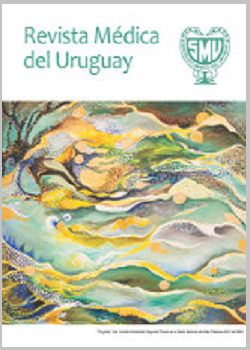Mohs micrographic surgery in Uruguay
First 130 cases in cutaneous carcinomas
Abstract
Introduction:
Mohs micrographic surgery is a technique for the excision of skin cancer with histologic analysis of 100% of the surgical margins, achieving the highest cure rate, while allowing maximum preservation of surrounding healthy tissue.
Objective:
to perform a clinical-epidemiologic description of our first 130 surgeries at the Hospital de Clínicas.
Method:
descriptive analysis of all patients operated by a single Mohs surgeon in our Dermatologic Surgery Unit between November 2013 and June 2016. Clinical, tumoral and surgical data was registered.
Results:
130 surgeries performed in 90 patients were studied. 62.3% were male patients and 37.7% female. Mean age was 68 years (range: 33 - 90 years). 67.7% resided in Montevideo and 32.3% from other parts of the country. 68% corresponded to basal cell carcinoma, and 32% to squamous cell carcinoma. 91.5% were primary tumors, and 8.5% were recurrent. 75.3% were located on the head and neck region. The most frequently used method of closure were flaps in 43% (56). Up to this moment, 70 patients have undergone follow-up for at least twelve months, and so far, only one case showed recurrence (1/70; 1.43%).
Conclusions:
Mohs surgery is safe and effective, and our results agree with reports of international reference centers. This is the first center in Uruguay with a Mohs Surgeon, and we present the first study in Uruguayan patients.
References
(1) Benedetto PX, Poblete-López C. Mohs micrographic surgery technique. Dermatol Clin 2011; 29(2):141-51.
(2) Connolly SM, Baker DR, Coldiron BM, Fazio MJ, Storrs PA, Vidimos AT, et al. AAD/ACMS/ASDSA/ASMS 2012 appropriate use criteria for Mohs micrographic surgery: a report of the American Academy of Dermatology, American College of Mohs Surgery, American Society for Dermatologic Surgery Association, and the American Society for Mohs Surgery. J Am Acad Dermatol 2012; 67(4):531-50.
(3) Blechman AB, Patterson JW, Russell MA. Application of Mohs micrographic surgery appropriate-use criteria to skin cancers at a university health system. J Am Acad Dermatol 2014; 71(1):29-35.
(4) Bichakjian CK, Olencki T, Aasi SZ, Alam M, Andersen JS, Berg D, et al. Basal Cell Skin Cancer, Version 1.2016, NCCN Clinical Practice Guidelines in Oncology. J Natl Compr Canc Netw 2016; 14(5):574-97.
(5) Goldenberg A, Ortíz A, Kim SS, Jiang SB. Squamous cell carcinoma with aggressive subclinical extension: 5-year retrospective rewiev of diagnostic predictors. J Am Acad Dermatol 2015; 73(1):120-6.
(6) Ocampo-Candiani J, Vidaurri LM, Olazarán Medrano Z. Cirugía micrográfica de Mohs en tumores malignos de la piel. Med Cutan Iber Lat Am 2004; 32(2):65-70.
(7) Grosfeld EC, Smit JM, Krekels GA, van Rappard JH, Hoogbergen MM. Facial reconstruction following Mohs micrographic surgery: a report of 622 cases. J Cutan Med Surg 2014; 18(4):265-70.
(8) Ibrahim AM, Rabie AN, Borud L, Tobias AM, Lee BT, Lin SJ. Common patterns of reconstruction for Mohs defects in the head and neck. J Craniofac Surg 2014; 25(1):87-92.
(9) Wain RA, Tehrani H. Reconstructive outcomes of Mohs surgery compared with conventional excision: A 13-month prospective study. J Plast Reconstr Aesthet Surg 2015; 68(7):946-52.
(10) Leibovitch I, Huilgol SC, Selva D, Richards S, Paver R. Basal cell carcinoma treated with Mohs surgery in Australia I. Experience over 10 years. J Am Acad Dermatol 2005; 53(3):445-51.
(11) Ruiz-Salas V, Garcés JR, Miñano Medrano R, Alonso-Alonso T, Rodríguez-Prieto MÁ, López-Estebaranz JL, et al. Descripción de los pacientes intervenidos mediante cirugía de Mohs en España: datos basales del registro español de cirugía de Mohs (REGESMOHS). Actas Dermosifiliogr 2015; 106(7):562-8.
(12) Veronese F, Farinelli P, Zavattaro E, Zuccoli R, Bonvini D, Leigheb G, et al. Basal cell carcinoma of the head region: therapeutical results of 350 lesions treated with Mohs micrographic surgery. J Eur Acad Dermatol Venereol 2012; 26(7):838-43.
(13) Macfarlane L, Waters A, Evans A, Affleck A, Fleming C. Seven years' experience of Mohs micrographic surgery in a UK centre, and development of a UK minimum dataset and audit standards. Clin Exp Dermatol 2013; 38(3):262-9.
(14) Lee DA, Miller SJ. Nonmelanoma skin cancer. Facial Plast Surg Clin North Am 2009; 17(3):309-24.
(15) Hussain W, Affleck A, Al-Niaimi F, Cooper A, Craythorne E, Fleming C, et al. Safety, complications and patients' acceptance of Mohs micrographic surgery under local anaesthesia: results from the UK MAPS (Mohs Acceptance and Patient Safety) Collaboration Group. Br J Dermatol 2016; 176(3):806-8.
(16) Leibovitch I, Huilgol SC, Selva D, Hill D, Richards S, Paver R. Cutaneous squamous cell carcinoma treated with Mohs micrographic surgery in Australia I: experience over 10 years. J Am Acad Dermatol 2005; 53(2):253-60.
(17) Alonso T SnP, González A, Ingelmo J, Ruiz I, Delgado S, Rodríguez M. Mohs micrographic surgery our first 100 patients. Actas Dermosifiliogr 2008; 99(4):275-80.
(18) Cardoso F DSB. Mohs micrographic surgery: a study of 83 cases. An Bras Dermatol 2012; 87(2):228-34.
(19) Hafiji J, Hussain W, Salmon P. Mohs surgery spares the orbicularis oris muscle, optimizing cosmetic and functional outcomes for tumours in the perioral region: a series of 407 cases and reconstructions by dermatological surgeons. Br J Dermatol 2015; 172(1):294-6.
(20) Mehrany K, Weenig RH, Pittelkow MR, Roenigk RK, CC. O. High recurrence rates of Basal cell carcinoma after mohs surgery in patients with chronic lymphocytic leukemia. Arch Dermatol 2004; 140(8):985-8.
(21) Leitenberger JJ, Rogers H, Chapman JC, Maher IA, Fox MC, Harmon CB, et al. Defining recurrence of nonmelanoma skin cancer after Mohs micrographic surgery: Report of the American College of Mohs Surgery Registry and Outcomes Committee. J Am Acad Dermatol 2016; 75(5):1022-31.
(22) Leibovitch I, Huilgol SC, Selva D, Richards S, Paver R. Basal cell carcinoma treated with Mohs surgery in Australia II. Outcome at 5-year follow-up. J Am Acad Dermatol 2005; 53(3):452-7.













